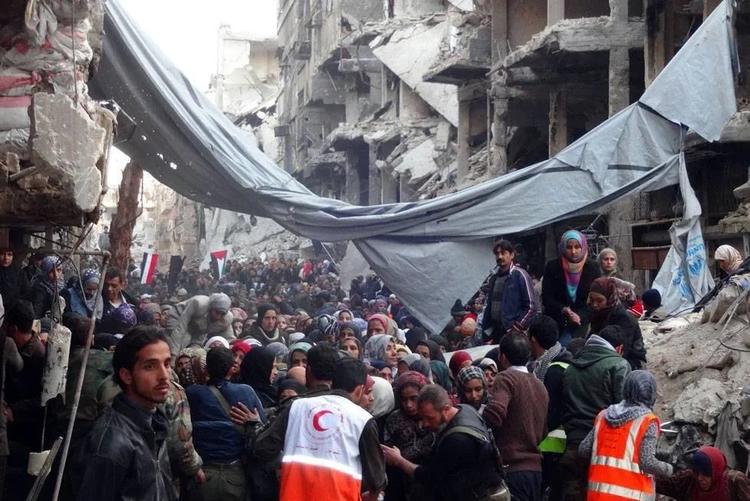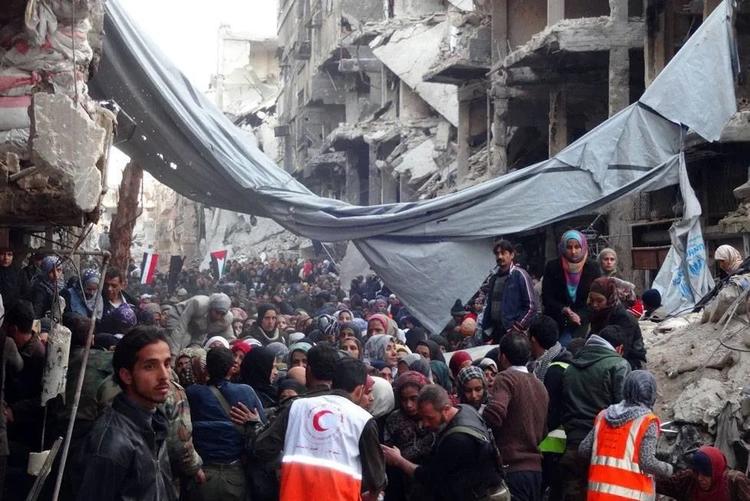By then, these camps no longer served that original purpose of housing people “who have been forced to leave their homes and seek refuge elsewhere, especially in a foreign country, from war, religious persecution…” as one dictionary puts it. Active hostilities having ended, the Palestinians were ready, able and, indeed, excited to do what they had always assumed they would do: go home. One force, and one force alone, blocked them: the nascent State of Israel. The moment Israel physically prevented them from returning home, their tent villages became Israeli internment camps — “in which prisoners of war, enemy aliens, political prisoners, etc., are detained without trial” — maintained by the UN on Israel’s behalf.
And so it remains to this day, except that concrete has replaced the tents.
Like so much of the mainstream language used to explain what is happening with Israel and the Palestinians, the framing of these places as “refugee camps” distorts reality for Israel’s benefit, and yet this is so ubiquitous that we repeat it without a thought. The narrative needs to change. The term tells a public already conditioned to see Israel-Palestine as a “conflict” with “two sides”, that the camps are the result of complicated historical circumstances, a tragedy without a specific perpetrator.
This obscures the simple reality that Israel has for seventy-five years blocked the people in the camps from going home simply because they are not Jewish. That, for the Zionists, has always been the Palestinians’ “crime”. It is why Israel ethnically cleansed about 800,000 Palestinians in 1948 and 300,000 more in 1967, and why it continues its slow-motion ethnic cleansing even as you read this. It is why the camps in which they remain holed up can only be called internment camps. Accuracy is important; consider, for example, the rightful outrage if the US were to call the camps in which it interned Japanese US residents during World War Two “refugee camps”.
Israel’s determination to keep non-Jews from going home is a principal reason why the Zionists assassinated UN Mediator Count Folke Bernadotte in September 1948 (he was in all likelihood killed by the Israeli state itself). For Bernadotte, the refugees’ freedom to go home was non-negotiable: “It would be an offence against the principles of elemental justice,” he had insisted shortly before his murder, “if these innocent victims of the conflict were denied the right to return to their homes while Jewish immigrants flow into Palestine…”
Bernadotte’s murder quickly inspired UN General Assembly Resolution 194, which codified refugees’ right of return, and the fulfilment of which became a condition for Israel’s membership of the UN in 1949. In response, Israel formally declared that it “unreservedly accepts the obligations of the United Nations Charter and undertakes to honour them from the day when it becomes a Member of the United Nations.”

Yarmouk camp, Syria, ‘the refugee camp that shames the world’ [UNRWA]
Even overlooking that compliance should have preceded admission, it begs credulity to suggest that any of the states supporting Israel’s admission actually believed its promises to abide by the terms of its membership, especially given the nascent state’s consistent behaviour to date.
There were saner voices, though. British Consul-General Cyril Marriott warned that the UN “should be aware of the barbarous nature of the country now applying for membership,” but the historical record suggests that Israel’s supporters, then as now, were quite well aware of its “barbarous nature”.
And so, it no doubt came as no surprise to them that Israel reneged on its assurances immediately after admission to the UN. Instead of being forced to comply, Israel’s betrayal was rewarded with heightened impunity as it continued with the ethnic cleansing of the Palestinians and the theft of their houses, land, orchards, businesses, infrastructure, possessions and commerce. For thousands of displaced Palestinians, “home” was but a short walk over an imaginary Green Line; many people could even see their homes, but they were shot on sight for merely attempting to reach them.
Perhaps the most illustrative example today is the Shuafat refugee — internment — camp. Shuafat is in East Jerusalem, which Israel claims to have annexed; in other words, according to Israel, the people in Shuafat already live in Israel. They don’t need to “return”, yet they remain interned by Israel because they are not Jewish.
![In Gaza, twice displaced, a tent camp set up as a result of refugees' homes destroyed by Israel's 'Cast Lead' military offensive in 2009 [Tom Suárez]](https://i0.wp.com/www.middleeastmonitor.com/wp-content/uploads/2023/08/suarez_gaza_2009.jpg?resize=500%2C333&quality=85&strip=all&zoom=1&ssl=1)
In Gaza, twice displaced, a tent camp set up as a result of refugees’ homes destroyed by Israel’s ‘Cast Lead’ military offensive in 2009 [Tom Suárez]
Decades ago, the Zionist assumption was that by blocking their return, the refugees would be permanently incorporated into the surrounding populations, consummating their crime of ethnic cleansing and leaving Israel free to pursue its ethnic-supremacy without talk of refugees. That hasn’t happened; the Palestinians have refused to erase themselves on Israel’s behalf. And so it was precisely to force this conclusion — to end the very recognition that the camps’ people are displaced Palestinians — that in 2018 Israel’s archangel, Donald Trump, sought to defund UNRWA, the principal agency responsible for maintaining the camps.
The common parlance serves to shield the public from the crime that they have been brainwashed into supporting; it “complicates” the right of human beings to return to their own homes on their own land and continue their own lives. Approximately 1.5 million Palestinians languish in internment camps on behalf of Israel. A further 3.5 million, while not technically in camps, are also blocked from going home so that Israel can pursue ethnic “purity” from the River Jordan to the Mediterranean Sea. If we stop repeating the evasive term “refugee camps” and start correctly identifying these as Israel’s internment camps for non-Jews, perhaps their liberation will come sooner rather than later.
The views expressed in this article belong to the author and do not necessarily reflect the editorial policy of Middle East Monitor or Informed Comment.
 Unless otherwise stated in the article above, this work by Middle East Monitor is licensed under a Creative Commons Attribution-NonCommercial-ShareAlike 4.0 International License
Unless otherwise stated in the article above, this work by Middle East Monitor is licensed under a Creative Commons Attribution-NonCommercial-ShareAlike 4.0 International LicenseThomas Suarez is a London-based historical researcher as well as a professional Juilliard-trained violinist and composer. A former West Bank resident, he devoted several years to researching poorly-tapped and newly-declassified historical archives. His previous books include three landmark works on the history of cartography and Writings on the Wall: Palestinian Oral Histories



 © 2025 All Rights Reserved
© 2025 All Rights Reserved